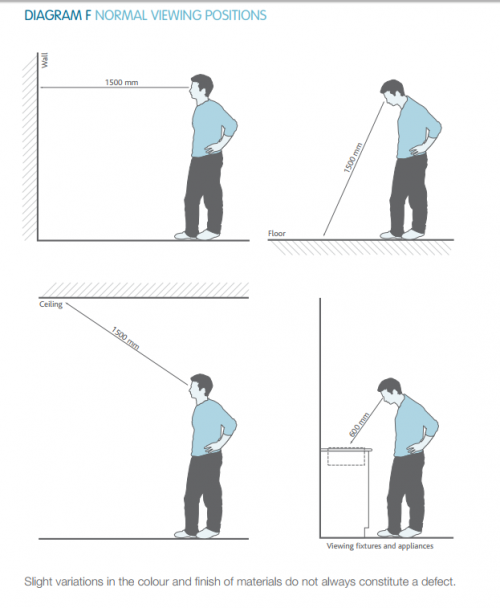STANDARD OF PAINTING
Coatings used are to be suitable for the relevant conditions and relevant wear and tear. Unless documented otherwise, painting is defective if it does not comply with the manufacturer’s installation instructions or AS/NZS 2311 – Guide to the painting of buildings.
Why does the paint job in my new home look so bad?
Many builders of new houses specify only two coats of paint on new plasterboard. They do this to cut costs, and because they often get away with it. This does not meet AS/NZS 2311 – Guide to the painting of buildings. It can mean that the paintwork will have lower durability, or worse still, that no sealer is applied, leading to pre-mature paint failure.
The standard for painting requires a minimum of three coats on all new unsealed surfaces, unless the manufacturer states otherwise. The first coat must be a plasterboard sealer, to seal the plasterboard joins, and the plasterboard. The following coats should be top-coats; that means they offer a level of washability or scrubbability. Ask to see the builder's specification before you sign any contracts, and make sure it meets the requirements of AS/NZS 2311 – Guide to the painting of buildings. If it doesn't say three coats, there isn't much you can do about it after the day of handover. Make sure the specification meets the standards, and ask for a variation if it doesn't, before you accept hand-over from the builder.
Another common practice is to use matt paint on walls. This is used to hide imperfections in the plaster. It might look ok at first, but matt paint does not have the washability or scrubbability of low-sheen paint. Insist on low-sheen paint for your interior walls.
INSPECTING THE PAINTWORK
Generally, variations in the surface colour, texture and finish of walls, ceilings, floors and roofs, and variations in glass and similar transparent materials are to be viewed where possible from a normal viewing position, defined as looking at a distance of 1.5 m or greater (600 mm for appliances and fixtures) with the surface or material being illuminated by ‘non-critical light’ , which is the light that strikes the surface, is diffused and is not glancing or parallel to that surface.

SURFACE FINISH OF PAINTWORK
Paintwork is defective if application defects or blemishes such as paint runs, paint sags, wrinkling, dust, bare or starved painted areas, colour variations, surface cracks, irregular and coarse brush marks, sanding marks, blistering, uniformity of gloss level and other irregularities in the surface that are visible from a normal viewing position. (Normal viewing position is 1.5 metres directly in front of surface)
Excessive over-painting of fittings, trims, skirtings, architraves, glazing and other finished edges is a defect.
NAIL AND SCREW FIXINGS
Fixings or unfilled depressions caused by fixings are defects in painted or stained surfaces if they can be seen from a normal viewing position. (Normal viewing position is 1.5 metres directly in front of surface)
MECHANICAL DAMAGE AND NATURAL DEFECTS IN SURFACES
Holes and any other unfilled depressions in painted or stained timber such as surface defects caused by mechanical damage, natural characteristics such as gum pockets or surface splits are defects if they can be seen from a normal viewing position. (Normal viewing position is 1.5 metres directly in front of surface)
PAINT DURABILITY
Unless documented otherwise, coatings are defective if they fail by lifting, blistering, flaking, fading etc. within the minimum period shown in table below.
MINIMUM DURABILITY OF COATED FINISHES
COATING MINIMUM DURABILITY
Exterior Acrylic 36 months (12 months in QLD)
Exterior Enamel 24 months (12 months in QLD)
Exterior semitransparent stains 12 months
Exterior clear finishes Not recommended
Interior – all finishes 36 months (12 months in QLD)




